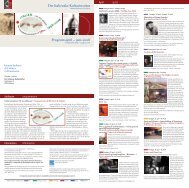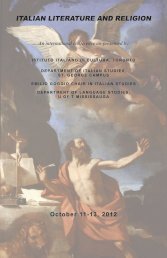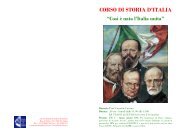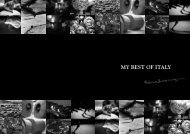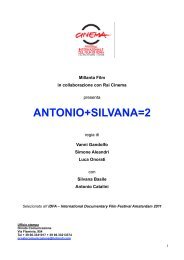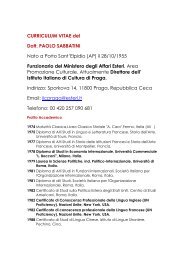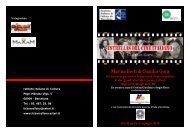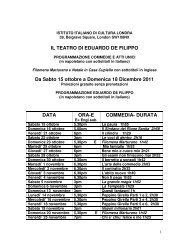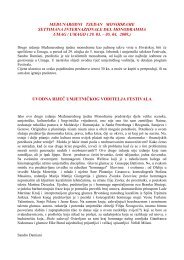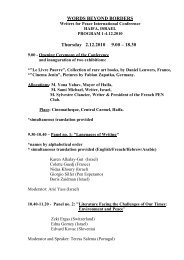Untitled - Ministero degli Affari Esteri
Untitled - Ministero degli Affari Esteri
Untitled - Ministero degli Affari Esteri
Create successful ePaper yourself
Turn your PDF publications into a flip-book with our unique Google optimized e-Paper software.
L’artista lascia emergere tra i segni ed i toni<br />
dettati alle morsure quel mondo di “figure”<br />
sottratte ad un bagaglio di memorie,<br />
scrutate tra le pieghe del tempo, spiando nei<br />
suoi flussi dagli “ombelichi” che popolano<br />
gli spazi dell’esistenza. Nella misura in cui<br />
l’acquatinta indulge ad un carattere pittorico<br />
vi fa ricorso Renata Boero. Il colore, il suo<br />
impiego “cromogrammatico”, declinando,<br />
licenziosamente, il titolo (Cromogrammi)<br />
di un noto ciclo della pittrice orientato a<br />
rivelare le trasformazioni della materiacolore,<br />
risulta al centro di queste pagine<br />
incise. Renata ne dosa le impronte tra le<br />
morsure, muovendo con agilità tra gli strati<br />
di vernice e di polvere che ricoprono la<br />
lastra. È un modo di procedere dinamico<br />
che tralascia le strutture definite per una<br />
scrittura ritmata, protesa a registrare, tra il<br />
segno energico dell’acquaforte e le graniture<br />
dell’acquatinta, i «tanti, piccoli, grandi<br />
episodi quotidiani che – annotava –<br />
il silenzio fa urlare», disposta a «mettere<br />
in scena» il suono di quel silenzio.<br />
Nella medesima esigenza del colorare<br />
la pagina, macchiarla quasi di un effetto<br />
a carboncino, Francesco Cecchetto impiega<br />
l’acquatinta. Si devono poi alle morsure<br />
dell’acquaforte i piccoli segni leggeri,<br />
circoscritti da forme disegnate alla luce<br />
dalla profondità del nero. Sono forme<br />
che l’artista lascia affiorare dal substrato<br />
della coscienza, trascrivendo le emozioni<br />
avvertite nello sporgersi tra le sponde<br />
di un paesaggio acquisito allo sguardo<br />
dell’anima. Alla seduzione del paesaggio<br />
cede anche Anna Crescenzi : uno scenario<br />
in qualche modo descritto, ponendo<br />
al centro di queste trascrizioni evidenti<br />
tracce figurali. Una matrice questa non<br />
nuova nella sua pratica creativa che Anna<br />
ha rimodellato nell’esperienza odierna,<br />
seguendo le potenzialità del “mezzo”,<br />
vale a dire bilanciando tra la corsività dei<br />
segni all’acquaforte e la cromia dettata<br />
dall’acquatinta. Si profila così, tra gli effetti<br />
desiderati, il suo disegnare figure assunte<br />
da un repertorio memoriale, dalla materia<br />
silence “on the stage”. With the same need<br />
to colour the page, to almost stain it with<br />
a charcoal effect, Francesco Cecchetto uses<br />
the aquatint. The small light signs are due to<br />
the bites of the etching surrounded by forms<br />
drawn in the light by the depth of the black.<br />
They are forms that the artist lets emerge<br />
from the background of his conscience,<br />
recording the emotions felt while leaning<br />
into the borders of a landscape taken from<br />
the vision of the soul.<br />
Anna Crescenzi also yields to the seduction<br />
of the landscape: a scene described in some<br />
way, placing evident traces of figures in the<br />
centre of these transcriptions. This is not<br />
a new matrix in Anna’s creativity. She has<br />
remodelled it following the potential of the<br />
“medium”, which is a balance between the<br />
cursiveness of the signs of an etching and<br />
the shades of colour of aquatint.<br />
This is how her design of figures, among<br />
desired effects, is possible. The figures are<br />
taken from a collection of memories, from<br />
the flexible matter of time that transforms<br />
things making them come back to life by the<br />
light of an imaginary substance.<br />
Aquatint also for Hsiao Chin and Peter<br />
Freeth. The indirect process is combined<br />
with a silkscreen passage for the Chinese<br />
artist, whose usual calligraphic mark seems<br />
to be, in today’s circumstances, closed,<br />
perhaps instigated by a literary requirement.<br />
So the fluidity remains and with this,<br />
calculating the bite time in particular,<br />
he sets up the draft, the harmonious<br />
distribution from the plate to the project,<br />
to that “conformed” surface on which the<br />
signs stand out like symbols of interior<br />
warnings that have been driven away. Freeth<br />
controls the effects of the acid to produce<br />
images that are almost crumbled. He uses<br />
aquatint with a soft ground to obtain<br />
the softness of charcoal. His are images<br />
of a landscape studied in the connection<br />
between nature and architecture, planes<br />
and volumes that blend, modulated and<br />
emphasised by subtle passages of tone,<br />
extracting more or less grain from the<br />
29



